
State Game and Fish Department enforcement chief Robert Timian said this winter should provide plenty of opportunities for anglers, as long as Mother Nature cooperates.
“Access to area lakes shouldn’t be an issue with the lack of snow, but that can change in a hurry,” Timian said. “As of right now, it is just a matter of waiting for the ice to become thick enough.”
Timian said ice conditions shouldn’t be judged by appearance alone, especially this time of year as ice thickness can vary significantly rather quickly.
“The edges become solid before the center, so anglers should drill test holes as they make their way out on the lake,” Timian said. “And then, an ice chisel should be used to check thickness while moving around.”
In addition, snow insulates ice, which in turn inhibits solid ice formation, and hides cracks, weak and open water areas. Anglers should avoid cracks, pressure ridges, slushy or dark areas, and areas around partially submerged trees.
“All of this signals thinner ice,” Timian said.
The following minimums are recommended for travel on clear-blue lake ice formed under ideal conditions. However, Timian said early in winter it’s a good idea to double these figures to be safe: 4 inches for a group walking single file; 6 inches for a snowmobile or all-terrain vehicle; 8-12 inches for an automobile; and 12-15 inches for a pickup/truck.
“While we can and do provide information to assist in assessing if the ice is reasonably safe, it is still up to the individual to decide when to go out on the ice,” Timian said.
Winter anglers should wear a personal flotation device, and carry ice picks or a set of screwdrivers to pull yourself back on the ice if you fall through.
If someone breaks through the ice, Timian said 911 should be called immediately, with rescue attempts used by employing a long item such as a pole, board or rope. If that’s not possible, throw the victim a life jacket, empty water jug or other buoyant object.
“Going to the victim should be used as a last resort, but only by forming a human chain where rescuers lie on the ice with each person holding the feet of the person in front,” Timian said.
To treat hypothermia, Timian said to replace wet clothing with dry clothing and immediately transport the victim to a hospital.